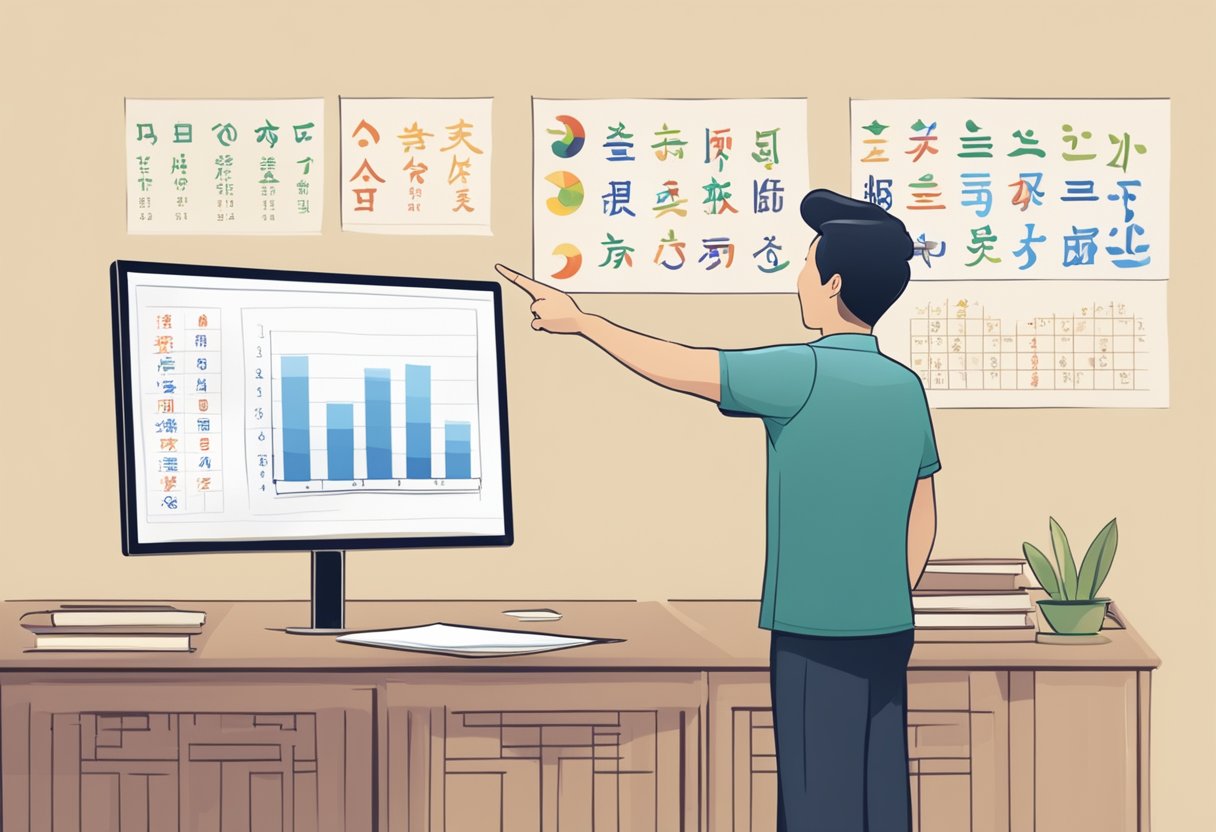The Ultimate Guide to Learning Chinese Pinyin
Learning Chinese can feel overwhelming, especially when faced with thousands of intricate characters. That's where pinyin comes in—a phonetic system that uses the Roman alphabet to represent Mandarin sounds. Pinyin serves as your essential first step to mastering Chinese pronunciation, making it possible to read and speak without memorising complex characters straight away.

If you're just starting your Chinese language journey, pinyin will quickly become your best friend. It breaks down the intimidating sounds of Mandarin into familiar letters, helping you navigate tones and pronunciations that might otherwise seem impossible to grasp. With pinyin, you can start speaking Chinese phrases long before you've memorised your first character.
Key Takeaways
- Pinyin uses Roman letters to represent Chinese sounds, making pronunciation accessible for beginners without learning characters first.
- Understanding the structure of pinyin (initials, finals and tones) creates a solid foundation for authentic Mandarin pronunciation.
- Regular practice with pinyin helps you transition smoothly to character recognition whilst developing proper speaking habits from day one.
Getting Started with Pinyin

Pinyin is the essential phonetic tool that will help you pronounce Chinese words correctly. This romanization system bridges the gap between Chinese characters and their sounds, making it much easier for beginners to start speaking Mandarin.
Understanding Pinyin Basics
Pinyin (拼音) literally means "spelled sounds" and was created to help people learn the pronunciation of Chinese characters. Unlike English, each pinyin syllable consists of three parts: an initial (consonant), a final (vowel), and a tone mark.
The initials are similar to English consonants, but some have different pronunciations. For example, 'c' sounds like 'ts' and 'q' is closer to 'ch' but pronounced with your tongue behind your lower teeth.
Finals can be simple vowels (a, o, e, i, u, ü) or compound vowels like "ai", "ei", or "ao". The ü sound doesn't exist in English—it's made by saying "ee" while rounding your lips.
Pinyin syllables follow patterns. Not all combinations of initials and finals are possible in Mandarin, which actually makes the system easier to learn once you understand the rules!
The Significance of Tones in Mandarin
Mandarin is a tonal language, meaning the pitch pattern you use when pronouncing a syllable changes its meaning. There are four main tones plus a neutral tone:
- First tone (ā): high, level pitch
- Second tone (á): rising pitch, like asking a question
- Third tone (ǎ): falling then rising pitch
- Fourth tone (à): sharp falling pitch, like giving a command
- Neutral tone: light and short, without emphasis
For example, "ma" with different tones can mean mum (妈 - mā), hemp (麻 - má), horse (马 - mǎ), or scold (骂 - mà).
Tones might feel awkward at first, but they're crucial for being understood. Try exaggerating them when practising until they become natural. Many learners find using hand gestures that mimic the tone movements helpful while learning.
The Structure of Pinyin

Pinyin breaks down Mandarin sounds into manageable components that follow logical patterns. Understanding these structural elements will dramatically improve your pronunciation and help you decode Chinese characters more effectively.
The Anatomy of Syllables: Initials and Finals
Every pinyin syllable typically consists of an initial (a consonant) and a final (a vowel or vowel combination). The initial appears at the beginning of a syllable, like 'b' in 'bā' or 'm' in 'mā'. There are 21 initials in Mandarin, including familiar sounds like 'b', 'p', 'm' and trickier ones like 'x', 'q', and 'zh'.
Finals make up the rest of the syllable after the initial. They can be simple vowels (a, e, i, o, u, ü), compound finals (like 'ai', 'ei', 'ao') or nasal finals that end with 'n' or 'ng' (like 'an' or 'ang').
Some syllables don't have initials at all - they start directly with a final, like 'ān' or 'ài'. Learning to recognise these patterns makes pinyin much easier to grasp.
Getting to Grips with Tone Marks
Tone marks always appear above vowels in pinyin, following specific rules. In compound finals, the mark goes on the first vowel (like in 'huá') except when that vowel is 'i' or 'u' functioning as a glide, in which case it goes on the second vowel (like in 'xiào').
For 'ü', the tone mark replaces the two dots (ǘ, ǚ, ǜ). When writing pinyin without tone marks, numbers are sometimes used instead (ma1, ma2, ma3, ma4).
While typing pinyin, most input methods let you enter the letter followed by the number of the tone. For example, typing 'ni3 hao3' produces 'nǐ hǎo'.
Using our free online Chinese keyboard, you can learn how to type pinyin without having to install a Chinese input method on your device!
Mastering tone marks takes practice, but they're essential for correctly pronouncing words and being understood by native speakers.
Mastering Mandarin Pronunciation

Pronunciation is the gateway to speaking Chinese fluently. Proper pinyin mastery helps you sound more natural and builds confidence when conversing with native speakers.
Pronunciation Drills for English Speakers
Learning Mandarin pronunciation can be tricky if you're an English speaker. Some sounds simply don't exist in English! Take the "x" sound in pinyin - it's like saying "sh" but with your tongue positioned behind your lower teeth.
Start with the four tones. Practice saying "ma" in all tones daily: mā (high), má (rising), mǎ (falling-rising), and mà (falling). Record yourself and compare with native speakers.
Difficult consonants need special attention. The "q" sound (similar to "ch" but lighter) and "r" sound (not like the English "r") require regular practice. Try tongue twisters like "sì shì sì" (four is four) to master similar-sounding syllables.
Focus on problem areas unique to English speakers. Many struggle with "zh", "ch", and "sh" versus "j", "q", and "x". Create practice pairs like "zhī" and "jī" to train your ear and mouth to distinguish them.
Learning Strategies and Online Resources
Find a learning approach that works for you. Visual learners might benefit from YouTube channels like "Chinese Pronunciation" that show mouth positions for difficult sounds. Auditory learners should try podcasts focused on pinyin basics.
Online tools can accelerate your progress. The Pleco app offers audio pronunciations for every character. HelloChinese and DuoLingo provide interactive exercises specifically targeting pronunciation.
Consider working with online Chinese tutors for personalised feedback. A tutor can spot subtle pronunciation errors you might miss on your own.
Create a daily practice routine. Even 10 minutes of focused pronunciation drills is better than an hour of passive listening. Try shadowing – listen to a native speaker and repeat immediately after them.
Use mnemonic devices to remember tricky sounds. For example, the "ü" sound is like saying "ee" while puckering your lips as if to whistle.
Applying Pinyin in Real-Life Contexts

Pinyin serves as a bridge between learning Chinese characters and actually using Mandarin in everyday situations. It provides a practical framework for pronunciation that you can immediately apply to real conversations and cultural exploration.
Building Vocabulary with Pinyin
When building your Chinese vocabulary, pinyin acts as a fantastic scaffold. Start by focusing on high-frequency words that appear in daily conversations. Apps like Pleco or Anki allow you to create flashcards with both characters and pinyin, making revision more efficient.
Try categorising words by topics – food, transportation, greetings – and practise the pinyin pronunciation of each group. This method helps you memorise related vocabulary together, creating stronger mental connections.
Don't worry about mastering thousands of characters initially. With pinyin, you can recognise and pronounce around 500-1000 words fairly quickly, giving you a solid foundation for basic conversations.
Remember that tone markers are crucial for correct meaning. The word "mā" (mother) is completely different from "mǎ" (horse) – a distinction only the tones in pinyin can help you master!
Forming Sentences and Practising Fluency
Pinyin helps tremendously with sentence structure when you're starting out. Begin with simple patterns like subject-verb-object (我喝水 - Wǒ hē shuǐ - I drink water) and gradually build complexity.
Record yourself speaking sentences in pinyin and compare with native audio. This identifies pronunciation issues before they become habits. Language exchange partners can provide feedback on your tones – the aspect most learners struggle with.
Practical tip: Read children's stories written in pinyin before tackling character-only texts. This develops your confidence with Mandarin sentence flow.
Try shadow reading – listening to native speakers and repeating what they say with minimal delay. This technique builds muscle memory for proper pronunciation and natural speech rhythm.
Appreciating Chinese Culture Through Language
Understanding pinyin opens doors to authentic cultural experiences. You'll find yourself able to read restaurant menus, follow basic song lyrics, and understand common phrases in Chinese films.
Many Chinese courses use pinyin as a stepping stone to deeper cultural discussions. When you can pronounce historical names correctly, you'll connect more meaningfully with China's rich heritage and traditions.
Pinyin also helps you appreciate regional differences in Mandarin. While standard pronunciation is taught first, you'll eventually notice how Beijing, Shanghai and Taiwanese speakers have distinct accents and expressions.
Try following Chinese social media accounts that include pinyin subtitles. This exposes you to contemporary culture and slang that textbooks rarely cover.
Frequently Asked Questions

Learning Pinyin doesn't have to be complicated. These common questions address the quickest methods, useful resources, and practical approaches to mastering this essential foundation of Mandarin Chinese.
What's the quickest way to get the hang of Chinese Pinyin?
The fastest route to Pinyin proficiency is consistent daily practice with audio resources. Spend 15-20 minutes each day listening and repeating sounds, focusing particularly on the four tones which make or break your pronunciation.
Connecting Pinyin to familiar English sounds can help, but be careful not to oversimplify. The "x" in Pinyin doesn't match any English sound perfectly, so listen carefully to native speakers.
Apps like Pleco or HelloChinese offer bite-sized Pinyin lessons with audio that you can practise during commutes or breaks. Consistency trumps marathon study sessions every time.
Can I find a Pinyin chart that really breaks things down simply?
Absolutely! The Yoyo Chinese Pinyin chart is brilliant for beginners, with clear audio examples and visual mouth positions for each sound. It's organised logically by consonants and vowels.
The Arch Chinese Pinyin chart offers interactive elements where you can click on combinations to hear proper pronunciation. This helps you focus on troublesome sound pairs.
Several free printable charts are available online that colour-code the four tones, making it easier to visualise the pitch patterns as you practise.
How can I start learning Pinyin on a budget?
Free YouTube channels like Chinese With Mike and Yoyo Chinese offer comprehensive Pinyin lessons that walk through each sound systematically. These resources provide professional instruction without spending a penny.
Public libraries often have Mandarin learning resources, including audio materials for Pinyin practice. Many offer online access to premium language learning platforms for free with your library card.
Language exchange apps like HelloTalk connect you with native Mandarin speakers who can provide feedback on your Pinyin pronunciation through voice messages at no cost.
Know any ace places online for mastering Pinyin?
ChinesePod offers brilliant beginner podcasts that focus heavily on proper Pinyin pronunciation with natural context. Their elementary lessons break down sounds in a friendly, accessible way.
Reddit's r/ChineseLanguage community has pinned resources and weekly discussion threads where learners share Pinyin tips and receive feedback from more advanced speakers.
The Chinese Zero to Hero website features interactive Pinyin drills that adapt to your weak spots, helping you focus practice where you need it most. Their tone pair exercises are particularly helpful.
What are the essential basics I should know when starting with Pinyin?
Master the four tones first – they're absolutely crucial. The same syllable with different tones can have completely different meanings, like "mā" (mum) versus "mǎ" (horse).
Understand that Pinyin isn't perfectly phonetic to English speakers. Sounds like "q", "x" and "c" don't match their English counterparts, so listening is vital.
Learn the syllable structure rules – not all consonants can be combined with all vowels. Focusing on valid combinations will save you loads of time and confusion.
Is there a practical method to convert Pinyin back to Chinese characters?
Input methods on smartphones and computers let you type Pinyin to generate character options. Just type "ni hao" and select the characters 你好 from the suggestions.
Several online converters like MDBG.net allow you to paste Pinyin text and get character options. These tools are brilliant when you hear something and want to see how it's written.
Remember that one Pinyin syllable often corresponds to multiple possible characters. Context is key for accurate conversion, which is why dictionaries like Pleco show usage examples alongside definitions.